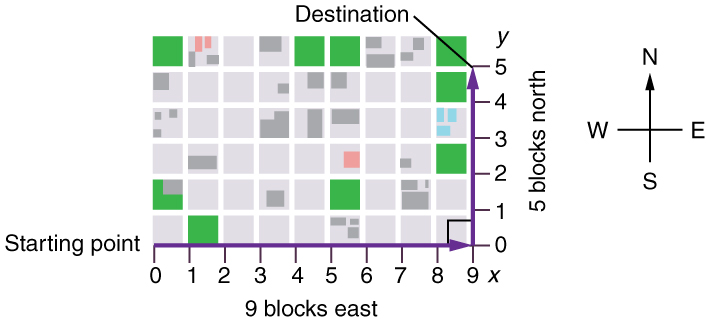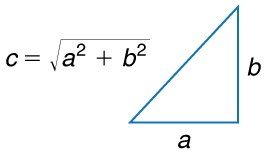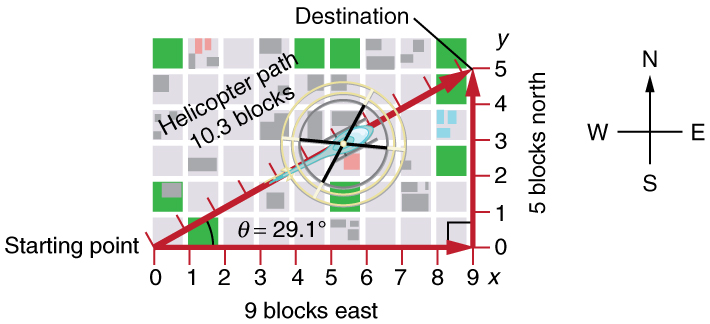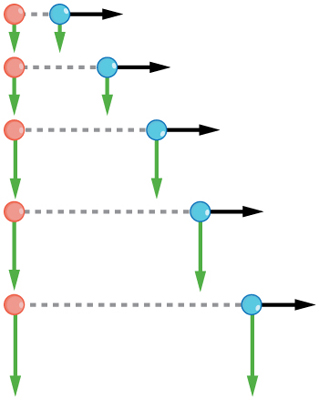[OpenStax College Physics 2e: Two-dimensional kinematics] Two-dimensional motion: Introduction to two-dimensional motion
 Motion in two dimensions: an introduction
Motion in two dimensions: an introduction
Two-dimensional motion: walking in a city
Suppose you want to walk from one point to another in a city with uniform square blocks, as pictured in Figure 1.

The straight-line path that a helicopter might fly is blocked to you as a pedestrian, and so you are forced to take a two-dimensional path, such as the one shown. You walk #{14}# blocks in all, #\green{9}# east followed by #\orange{5}# north.
The example above serves as a motivation to try and compute straight-line distance between the starting point and the destination.
An old adage states that the shortest distance between two points is a straight line. The two legs of the trip and the straight-line path form a right triangle, and so the Pythagorean theorem, #\green{a}^{2}+\orange{b}^{2}=\blue{c}^{2}#, can be used to find the straight-line distance.

Returning to the first example, the hypotenuse of the triangle is the straight-line path, and so in this case its length in units of city blocks is \[\sqrt{(\green{9})^{2}+(\orange{5})^{2}}= \unit{\blue{10.3}}{\text{blocks}}\] which is considerably shorter than the #{14}# blocks you walked.

Distance walked vs straight-line distance
The fact that the straight-line distance, #\unit{\blue{10.3}}{\text{blocks}}#, in Figure 3 is less than the total distance walked #\unit{{14}}{\text{blocks}}#, is one example of a general characteristic of vectors. In terms of triangles, it says that the length of the hypotenuse is always smaller or equal to the sum of the lengths of the adjacent and opposite sides.
As for one-dimensional motion, we use arrows to represent vectors. The length of the arrow is proportional to the vector’s magnitude. The arrow’s length is indicated by hash marks in Figure 1 and Figure 3. The arrow points in the same direction as the vector.
Two-dimensional vectors
For two-dimensional motion, the path of an object can be represented with three vectors: one vector shows the straight-line path between the initial and final points of the motion, one vector shows the horizontal component of the motion, and one vector shows the vertical component of the motion. The horizontal and vertical components of the motion add together to give the straight-line path.
The independence of perpendicular motions
The person taking the path shown in Figure 3 walks east and then north (two perpendicular directions). How far they walk east is only affected by their motion eastward. Similarly, how far they walk north is only affected by their motion northward. In other words, motion along a given direction is independent of what happens along a perpendicular direction.
The horizontal and vertical components of two-dimensional motion are independent of each other. Any motion in the horizontal direction does not affect motion in the vertical direction, and vice versa.
This is true in a simple scenario like that of walking in one direction first, followed by another. It is also true of more complicated motion involving movement in two directions at once.
As an example, let us compare the motion of two baseballs.
Independent motions of a falling ball
One baseball is dropped from rest. At the same instant, another is thrown horizontally from the same height and follows a curved path. A stroboscope has captured the positions of the balls at fixed time intervals as they fall.

It is remarkable that for each flash of the strobe, the vertical positions of the two balls are the same. This similarity implies that the vertical motion is independent of whether or not the ball is moving horizontally.
The two-dimensional curved path of the horizontally thrown ball is composed of two independent one-dimensional motions (horizontal and vertical).
Resolving motion
The key to analyzing such motion, called projectile motion, is to resolve (break) it into motion along perpendicular directions. Resolving two-dimensional motion into perpendicular components is possible because the components are independent.
We shall see how to resolve vectors in Vector addition and subtraction: graphical methods and Vector addition and subtraction: analytical methods. We will find such techniques to be useful in many areas of physics.

Or visit omptest.org if jou are taking an OMPT exam.



